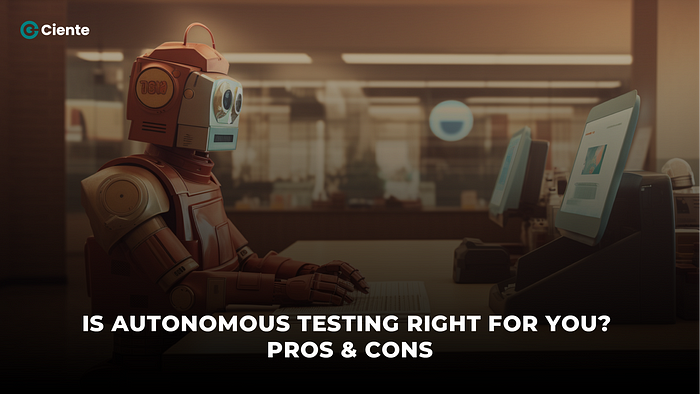Is Autonomous Testing Right for You? Pros & Cons

The world of software development is in a constant race against time. New features and updates need to be released quickly, but this can’t come at the expense of quality. Enter autonomous testing, a cutting-edge approach that leverages artificial intelligence (AI) to automate the testing process. But is it the right fit for your project? Let’s delve into the pros and cons of autonomous testing to help you decide.
What is Autonomous Testing?
Traditional automation testing involves scripting specific test cases that mimic user interactions. Autonomous testing takes it a step further. These AI-powered tools can not only execute tests but also learn and adapt over time. They can identify patterns, prioritize tests based on risk, and even generate new test cases on the fly. This allows for a more dynamic and comprehensive testing strategy.
Pros of Autonomous Testing
Increased Efficiency: Autonomous testing frees up your QA team’s valuable time. Repetitive tasks are handled by the AI, allowing testers to focus on more complex scenarios and exploratory testing. This can significantly speed up the testing process and get your software to market faster.
Improved Coverage: Autonomous testing tools can explore a wider range of scenarios than traditional automation scripts. They can identify edge cases and uncover bugs that manual testers might miss. This leads to a more robust and reliable product.
Reduced Costs: While there’s an initial investment in setting up autonomous testing tools, the long-term benefits can be significant. The increased efficiency and improved coverage can lead to cost savings in the development process.
Scalability: Autonomous testing tools can handle a large volume of tests with ease. This makes them ideal for complex projects with constantly evolving features. They can scale to meet the growing demands of your software.
Continuous Learning: Unlike traditional scripts, autonomous testing tools continuously learn and improve. They can adapt to changes in the software and identify new risks as they emerge. This ensures your testing remains relevant and effective throughout the software lifecycle.
Cons of Autonomous Testing
High Initial Investment: Implementing autonomous testing requires an investment in new tools and potentially additional training for your team. This can be a barrier for smaller companies or those with limited budgets.
Black Box Testing: One of the challenges of autonomous testing is the lack of transparency. The AI may identify a bug, but it can be difficult to understand the reasoning behind it. This can make it more challenging to debug and fix the issue.
Limited Creativity: While autonomous testing excels at repetitive tasks, it may struggle with creative problem-solving or testing for user experience (UX). Human testers are still essential for these areas.
Security Concerns: As with any AI technology, there are security concerns surrounding autonomous testing tools. It’s crucial to choose a reputable vendor with a strong focus on data security.
Evolving Technology: Autonomous testing is a rapidly evolving field. The tools and best practices are constantly changing. Staying up-to-date with the latest developments requires ongoing effort.
Is Autonomous Testing Right for You?
Autonomous testing offers significant benefits for software development teams, but it’s not a one-size-fits-all solution. Consider the following factors when deciding if it’s right for you:
Project complexity: For complex projects with a large volume of tests, autonomous testing can be a game-changer.
Budget: The initial investment needs to be weighed against the potential cost savings and improved quality.
Team expertise: If your team has experience with automation testing, the transition to autonomous testing will be smoother.
Project timeline: Autonomous testing can accelerate the testing process, which is beneficial for projects with tight deadlines.
The Future of Testing is Autonomous (with a Human Touch)
Autonomous testing is the future of software quality assurance. However, it’s important to remember that it complements, not replaces, human testers. The ideal approach combines the power of AI with the creativity and critical thinking of experienced QA professionals. By leveraging both, you can achieve a level of software quality that was once unimaginable.
Note: IndiBlogHub features both user-submitted and editorial content. We do not verify third-party contributions. Read our Disclaimer and Privacy Policyfor details.







